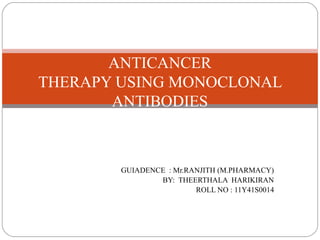
Major seminar1
- 1. ANTICANCER THERAPY USING MONOCLONAL ANTIBODIES GUIADENCE : Mr.RANJITH (M.PHARMACY) BY: THEERTHALA HARIKIRAN ROLL NO : 11Y41S0014
- 2. Conventional Anti-Cancer Therapy Chemotherapy: Imperfect Systematic nature of cytoxicity Agents lack intrinsic anti-tumor selectivity Anti-proliferative mechanism on cells in cycle, rather than specific toxicity directed towards particular cancer cell Host toxicity: treatment discontinued at dose levels well below dose required to kill all viable tumor cells 2
- 3. History Emil von Behring in 1890 Discovered antibodies Paul Ehrlich (16 years later) Coined phrase, “magic bullets and poisoned arrows” Kohler and Milstein in 1975 Discovery of monoclonal antibodies (mAb) directed against well-characterized antigens 3
- 4. Rationale Mab as efficient carriers for delivery of anti-tumor agents Enhanced vascular permeability of circulating macromolecules for tumor tissue. Normal tissue: blood vessels have intact endothelial layer Tumor tissue: blood vessels leaky and so small Tumor tissue generally do not have a lymphatic drainage 4 system.
- 5. Production of monoclonal antibodies Biotech Resources. 1989. Monoclonal antibody technology -- the basics. 5
- 6. Patho-physiology of Tumor Tissue Angiogenesis Hyper vasculature Impaired lymphatic drainage ***Due to these characteristics, tumors can be exploited for tumor-selective drug delivery 6
- 8. 3 mechanisms resulting in apoptosis Antigen cross-linking Activation of death receptors Blockade of ligand-receptor growth or survival pathways 8
- 9. 1. Antigen cross-linking Target growth factor receptor Antagonize ligand-receptor signaling Growth-factor signaling mediated by the receptor tyrosine kinase is inhibited EGFR (epidermal growth factor receptor) FGFR (fibroblast growth factor receptor) VEGFR (vascular endothelial growth factor) Results in arrest of tumor cell growth 9
- 10. 2. Activation of death receptors Death receptors : members of TNF receptors family. Cross-link targeted surface antigens on tumor cells and antibody agonists that mimic ligand-mediated activation of specific receptors Response: intracellular Ca II ions increase Activate caspase-3 and caspase-9 (involved in cell apoptosis) 10
- 12. 3. Delivery of cytotoxic agents Physically link antibodies to toxic substances for delivery Radio-immunoconjugates (aim of delivering radiation directly to the tumor) Toxin-immunoconjugates (deliver toxins intracellularly) Antibody-directed enzyme pro-drug therapy (ADEPT): localize enzymes to tumor cell surfaces 12
- 13. General drug delivery system Drug molecules bound to macromolecule through spacer molecule Drug released from macromolecule after cellular uptake of the conjugate Targeting moiety = monoclonal antibody 13
- 14. Toxin immunoconjugates 3 methods to attach cytotoxic drug to variable regions of mAb a. Couple drug to lysine moieties in the mAb b. Generation of aldehyde groups by oxidizing the carbohydrate region and subsequent reaction with amino- containing drugs or drug derivatives c. Couple drugs to sulfhydryl groups by selectively reducing the interchain disulfides near the Fc region of 14 the mAb
- 15. Immunoconjugate BR96-doxorubicin conjugate (BR96-DOX) Promising toxin-immunoconjugate mouse/human chimeric mAb Targets antigen over-expressed on surface of human carcinoma cells of breast, colon, lung, and ovary Disulfide reduction attaches mAb to drug, BR96 Dose that can be safely administered every 3 weeks is insufficient 15
- 16. 16
- 17. Other examples of toxin- immunoconjugates KS1/4-MTX Conjugate of methotrexate (MTX) Coupling of MTX to the lysine moieties of the mAb KS1/4-DAVLB Conjugate of vinca alkaloid derivatives Vinca alkaloid derivatives attached to amino groups of lysine residues on KS1/4 mAb 17
- 18. Why are these toxin-immunoconjugates unsuccessful? Cause gastrointestinal toxicity Inner regions of solid tumors poorly vascularized and have low blood flow (reduce amount of immunoconjugate reaching these parts of the tumor) Antigen expression is heterogenous on tumor cells Restricts the amount of cells that can be effectively targeted by antibody conjugates 18
- 19. ADEPT ENZYMES (Antibody- directed enzyme pro-drug therapy) Chemically link the mAb to the enzyme of interest; can also be a fusion protein produced recombinantly with the antibody variable region genes and the gene coding the enzyme Convert subsequently administered anti-cancer pro-drugs into active anti-tumor agents Upon binding to targeted enzymes, it is converted into active drug 19
- 21. Anti-growth factor mAb Therapy Angiogenesis Formation of nascent blood vessels VEGF Protect endothelial cells from apoptosis Activity mediated by tyrosine kinase receptors, VEGFR 1 and VEGFR 2 Functions indirectly as survival factor for tumor cells Inhibit VEGF signaling Block the receptor Inhibits tumor growth and metastasis Deprives tumors of nutrient-providing blood vessels 21
- 22. RITUXIMAB (rituxan) 1st therapeutic mAb approved by FDA in 1997 CD20 antigen function: cell cycle progression Binding Rituximab to CD-20 causes: autophosphorylation, activation of serine/tyrosine protein kinases -- induces apoptosis Response rates of 50% to 70% in follicular lymphomas Response rates of 90% to 100% when used in combination with various chemotherpay procedures 22
- 24. Toxic effects of Rituximab Short-lived mild reactions to infusion after first treatment: fever chills rashes and nausea 24
- 25. FDA-approved monoclonal antibodies for cancer treatment Name of drug Type of cancer it treats Alemtuzumab (Campath) Chronic lymphocytic leukemia Brain cancer Colon cancer Bevacizumab (Avastin) Kidney cancer Lung cancer Colon cancer Cetuximab (Erbitux) Head and neck cancers Source: Food and Drug Administration (FDA), Center for Drug Evaluation and Research 25
- 26. Estimated New Cancer Cases and Deaths Worldwide for Leading Cancer Sites by Level of Economic Development, 2008. Source: GLOBOCAN 26
- 27. CONCLUSION Researchers hope to define the optimal combinations of the use of mAb with conventional chemotherapeutic agents and with radiation therapy Determine best therapy candidates and expand clinical trials to other tumor types. 27
